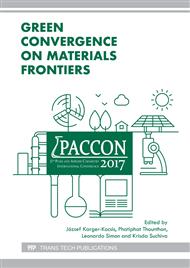[1]
G. Férey, C. Mellot-Draznieks, C. Serre, F. Millange, J. Dutour, S. Surblé, I. Margiolaki, A chromium terephthalate-based solid with unusually large pore volumes and surface area, Science 309 (2005) 2040-(2042).
DOI: 10.1126/science.1116275
Google Scholar
[2]
R.E. Hamm, Complex ions of chromium. II. trans-cis isomerization of potassium dioxalatodiaquochromate(III), J. Am. Chem. Soc. 75 (1953) 609-611.
DOI: 10.1021/ja01099a026
Google Scholar
[3]
S. Karmakar, H.L. Greene, Characterization of H-Y and Cr-Y Zeolite Catalysts during the Oxidative Destruction of CFC11 and CFC12, J. Catal. 148 (1994) 524-533.
DOI: 10.1006/jcat.1994.1238
Google Scholar
[4]
P. Maitarad, S. Namuangruk, D. Zhang, L. Shi, H. Li, L. Huang, B. Boekfa, M. Ehara, Metal-porphyrin: A potential catalyst for direct decomposition of N2O by theoretical reaction mechanism investigation, Environ. Sci. Technol. 48 (2014) 7101-7110.
DOI: 10.1021/es405767d
Google Scholar
[5]
D. Jacewicz, M. Szkatuła, A. Chylewska, A. Da̧browska, M. Woźniak, L. Chmurzyński, Coordinate cis-[Cr(C2O4)(pm)(OH2)2]+ cation as molecular biosensor of pyruvate's protective activity against hydrogen peroxide mediated cytotoxity, Sensors 8 (2008).
DOI: 10.3390/s8084487
Google Scholar
[6]
K.A. Kreisel, G.P.A., Yap, O. Dmitrenko, C.R. Landis, K.H. Theopold, The shortest metal-metal bond yet: Molecular and electronic structure of a dinuclear chromium diazadiene complex, J. Am. Chem. Soc. 129 (2007) 14162-14163.
DOI: 10.1021/ja076356t
Google Scholar
[7]
W.X.C. Oliveira, C.L.M. Pereira, C.B. Pinheiro, J. Cano, F. Lloret, M. Julve, Relatively strong intramolecular antiferromagnetic coupling in a neutral CrIII2NbV2 heterobimetallic molecular square, Chem. Commun. 51 (2015) 11806-11809.
DOI: 10.1039/c5cc04285b
Google Scholar
[8]
B. Boekfa, E. Pahl, N. Gaston, H. Sakurai, J. Limtrakul, M. Ehara, C-Cl bond activation on Au/Pd bimetallic nanocatalysts studied by density functional theory and genetic algorithm calculations, J. Phys. Chem. C 118 (2014) 22188-22196.
DOI: 10.1021/jp5074472
Google Scholar
[9]
B. Boekfa, S. Choomwattana, P. Khongpracha, J. Limtrakul, Effects of the zeolite framework on the adsorptions and hydrogen-exchange reactions of unsaturated aliphatic, aromatic, and heterocyclic compounds in ZSM-5 zeolite: A combination of perturbation theory (MP2) and a newly developed density functional theory (M06-2X) in ONIOM scheme, Langmuir 25 (2009).
DOI: 10.1021/la901841w
Google Scholar
[10]
M.J. Frisch, et. al. Gaussian 09 (Gaussian, Inc., Wallingford CT, 2009).
Google Scholar
[11]
A.G. MacDiarmid, G.B. Kauffman, D. Faoro, J. Gliksma, J.H. Worrell, Potassium cis-[Diaquabis(Oxalato)Chromate(III)] Dihydrate and Potassium trans-[Diaquabis(Oxalato)- Chromate(III)] Trihydrate, Inorg. Syn. 17 (2007) 147-152.
DOI: 10.1002/9780470132487.ch39
Google Scholar
[12]
J. Nenwa, O. Befolo, B. Gouet, M. Mbarkic, B.P.T. Fokwa, Pyridinium cis-diaquabis(oxalate-k2O, O')chromate(III), Acta Cryst. E68 (2012) m1434.
DOI: 10.1107/s1600536812044303
Google Scholar
[13]
I. Chérif, J. Abdelhak, M. Amami, E.K. Hlil, M.F. Zid, A. Driss, A new bis(oxalato)chromate(III) salt: synthesis, crystal structure, thermal behavior and magnetic properties of (C3H5N2)[Cr(C2O4)2(H2O)2]. 2H2O, QSci. Conn. (2013) 46.
DOI: 10.5339/connect.2013.46
Google Scholar


